NUS DEGs Developer Guide
Acknowledgements
{list here sources of all reused/adapted ideas, code, documentation, and third-party libraries – include links to the original source as well}
Design & implementation, Architecture

The Architecture Diagram given above explains the high-level design of the application.
The main logic of the application is handled by these four components
- Controller:
- Handles Commands coming from the User
- Combines data from the Model and UI Components from View
- Never handles data logic
- View:
- Responsible for printing onto the Command Line Application
- Model:
- Stores the data and data logic methods that handles and manages the data
- Performs REST API calls to the NUSModsAPI
- Storage:
- can save both schedule data and user data in .txt format, and read them back into corresponding objects.
- depends on some classes in the Model component
How the architecture components interact with each other

The Sequence Diagram above shows how the components interact with each other when the user inserts a module into his schedule
View Component
The component is specified in Ui.java
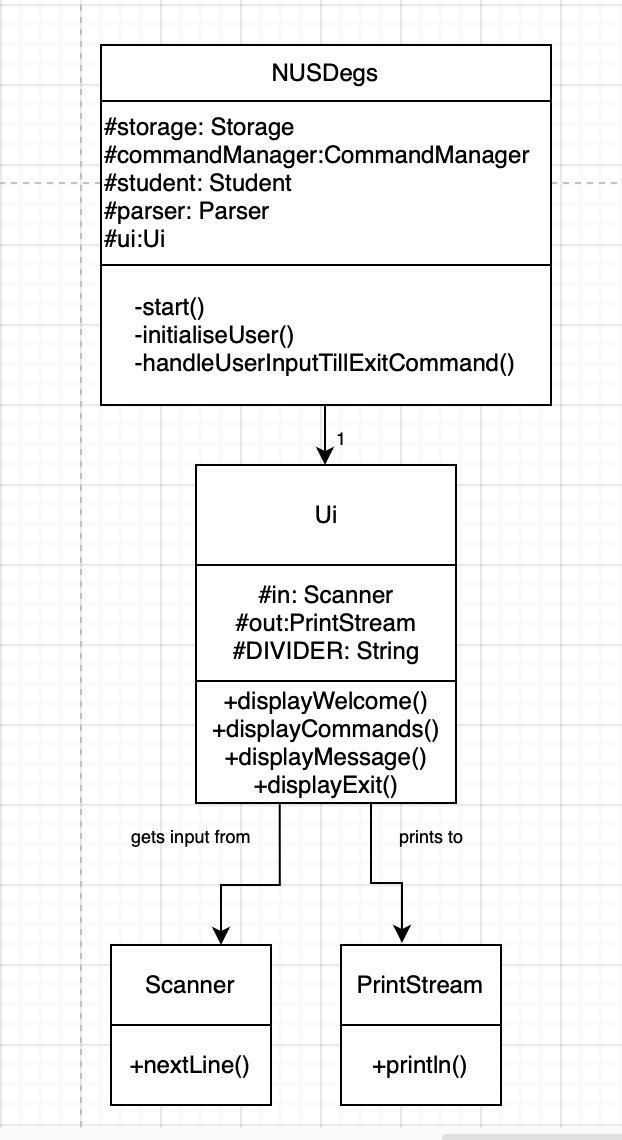
The UI component:
- displays messages to the user by printing to the CLI
- displays results from commands executed by the ModulePlannerController class
Controller Component

The Controller component:
- Input from the user is received through
Uiclass, is the pass intoModulePlannerController. - When
ModulePlannerControlleris called upon to execute a command, it uses theParserclass to parse forUserCommand. - This results in a
UserCommandobject which is executed by theModulePlannerController. - The
UserCommandcalls the methods specific to eachUserCommandfromModuleMethodsController. (ModuleServiceControllercontains helper functions forModuleMethodsController) - The result of the command execution is returned to the
Uiand printed to the CLI.
Model Component
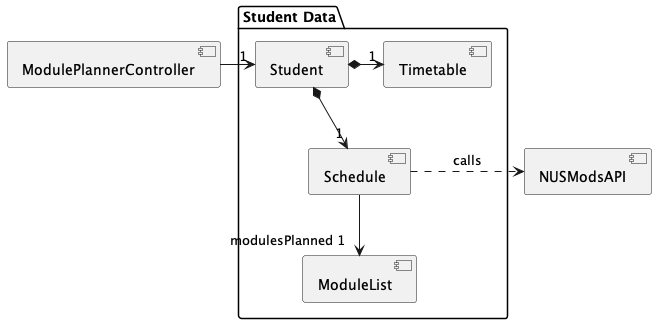
The Model component:
- Stores the student data
- Stores
Studentstudent that has student details (name, major, year),Scheduleschedule,Timetabletimetable and other student data (completedModuleCredits, majorModuleCodes, currentSemesterModules) - Stores
Scheduleschedule that hasModuleListmodulesPlanned, and other schedule data like modulesPerSem, completedModules - Stores
ModuleListmodulesPlanned - Stores
Timetabletimetable that has currentSemesterModulesWeekly
- Stores
- Makes REST API calls to NUSModsAPI
Storage Component
The component is specified in the storage package and facilitated by StorageManager.java
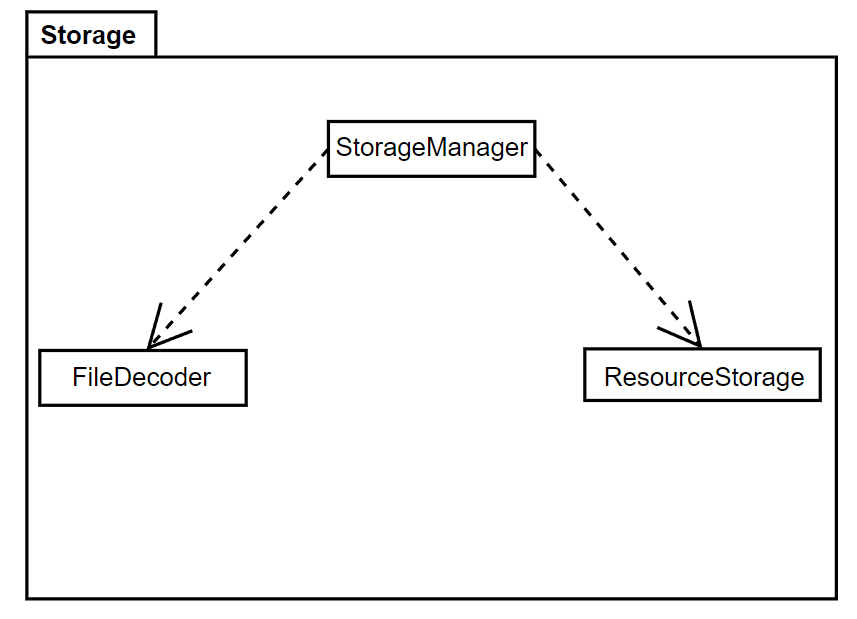
The storage component:
- can save the student’s name, major and year to
studentDetails.txtwhenever the user starts NUSDegs for the first time and read them back into corresponding objects. - can save the student’s schedule and timetable whenever it is updated in NUSDegs and read them back into corresponding objects.
- uses
FileDecoderclass to read saved files in the data folder back toStudentobject. - uses
ResourceStorageto store and retrieve core module details for CEG and CS. - depends on some classes in the
Modelcomponent (because theStoragecomponent’s job is to save/retrieve objects that belong to theModel)
Design Considerations: When to save data
- Alternative 1 (current choice): Save data after every change the user makes when NUSDegs is running
- Pros: Less chance of losing data due to crash
- Cons: More processing power and time needed
- Alternative 2: Save data after the user types the exit command
- Pros: Easier to implement, requires less processing power
- Cons: NUSDegs require constant internet connection, losing connection might lead to potential issues when saving data
Features featured in Developer’s Guide:
- Required
- Add
- Recommend
- Clear
- Info (description, command)
- Pace
- Left
Implementation
Required Feature
The following sequence diagram shows how the Required Command function works.
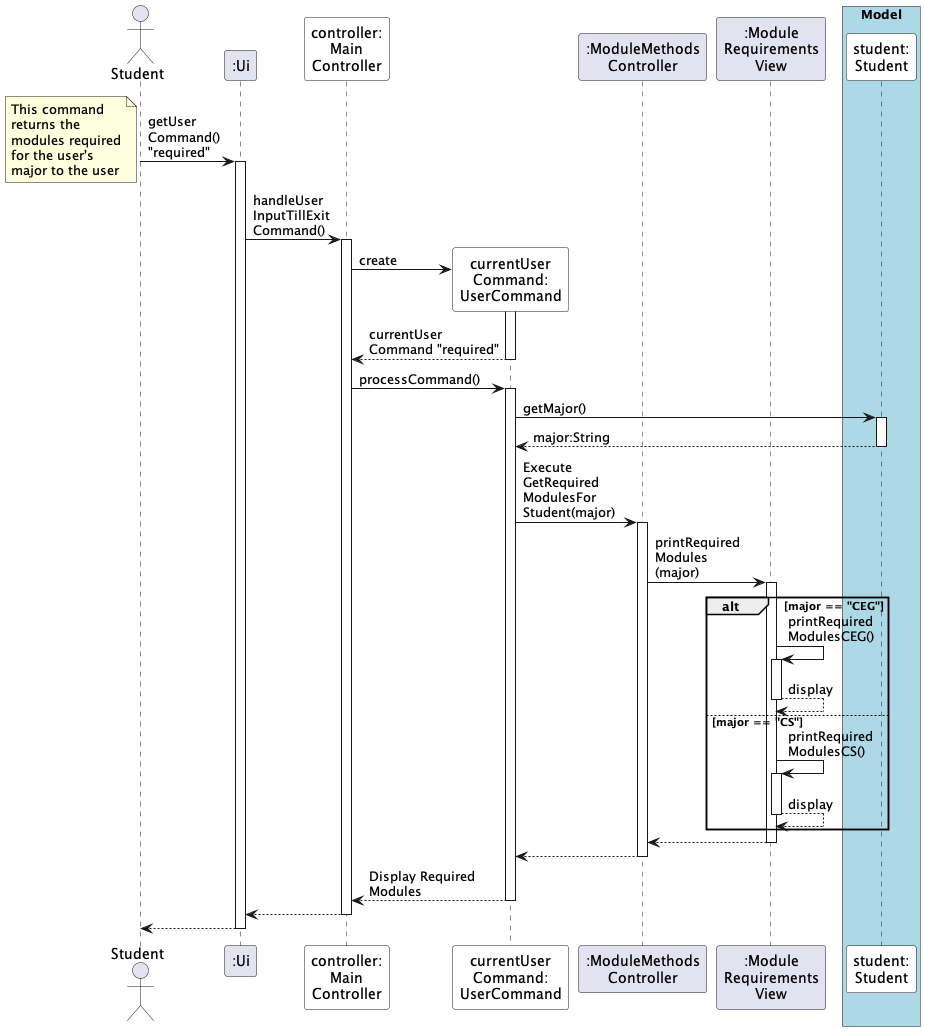
The required command is implemented to give users an overview of the modules they need to complete for their major. It is facilitated by major. Additionally, it implements the following operations:
Function List
student#getMajor()– Returns themajorof the student.ModuleMethodsController#executeGetRequiredModulesForStudent(major)- Calls functions below to print required modules for the user’s majorModuleRequirementsView#printRequiredModules(major)- Calls the specific printing function depending on the user’s majorModuleRequirementsView#printRequiredModulesCEG()- Specific printing function for CEG required modulesModuleRequirementsView#printRequiredModulesCS()- Specific printing function for CS required modules
Usage Examples
Here are a few examples of how the Show Required Modules Feature behaves:
Example of usage 1: (user’s major is CEG)
User input:
required
- Expected outcome:
#==========================================================#
║ Modular Requirements for CEG Units ║
#==========================================================#
+----------------------------------------------------------+
│ Common Curriculum Requirements 60 │
+----------------------------------------------------------+
GES1000 (Singapore Studies) 4
GEC1000 (Cultures and Connections) 4
GEN2000 (Communities and Engagement) 4
ES2631 Critique & Communication of Thinking
& Design (Critique & Expression) 4
CS1010 Programming Methodology (Digital
Literacy) 4
GEA1000 Quantitative Reasoning with Data (Data
Literacy) 4
DTK1234 Design Thinking (Design Thinking) 4
EG1311 Design and Make (Maker Space) 4
IE2141 Systems Thinking and Dynamics (Systems
Thinking) 4
EE2211 Introduction to Machine Learning
(Artificial Intelligence) 4
CDE2501 Liveable Cities (Sustainable Futures) 4
CDE2000 (Creating Narratives) 4
PF1101 Fundamentals of Project Management
(Project Management) 4
CG4002 Computer Engineering Capstone Project 1
(Integrated Project) 8
+----------------------------------------------------------+
│ Programme Requirements 60 │
+----------------------------------------------------------+
~~ Engineering Core 20 ~~
MA1511 Engineering Calculus 2
MA1512 Differential Equations for Engineering 2
MA1508E Linear Algebra for Engineering 4
EG2401A Engineering Professionalism 2
CP3880 Advanced Technology Attachment Programme 12
~~ CEG Major 40 ~~
CG1111A Engineering Principles and Practice I 4
CG2111A Engineering Principles and Practice II 4
CS1231 Discrete Structures 4
CG2023 Signals & Systems 4
CG2027 Transistor-level Digital Circuit 2
CG2028 Computer Organization 2
CG2271 Real-time Operating System 4
CS2040C Data Structures and Algorithms 4
CS2113 Software Engineering & Object-Oriented
Programming 4
EE2026 Digital Design 4
EE4204 Computer Networks 4
+----------------------------------------------------------+
│ Unrestricted Electives 40 │
+----------------------------------------------------------+
Example of usage 2: (user’s major is CS)
User input:
required
- Expected outcome:
#==========================================================#
║ Modular Requirements for CS Units ║
#==========================================================#
+----------------------------------------------------------+
│ Common Curriculum Requirements 40 │
+----------------------------------------------------------+
~~ University Requirements: 6 University Pillars 24 ~~
CS1101S Programming Methodology (Digital
Literacy) 4
ES2660 Communicating in the Information Age
(Critique and Expression) 4
GEC1% (Cultures and Connections) 4
GEA1000 / BT1101 / ST1131 / DSA1101 (Data
Literacy) 4
GES1% (Singapore Studies) 4
GEN2% (Communities and Engagement) 4
~~ Computing Ethics 4 ~~
IS1108 Digital Ethics and Data Privacy 4
~~ Inter & Cross-Disciplinary Education 12 ~~
Interdisciplinary (ID) Courses (at least 2)
Cross-disciplinary (CD) Courses (no more than 1)
+----------------------------------------------------------+
│ Programme Requirements 80 │
+----------------------------------------------------------+
~~ Computer Science Foundation 36 ~~
CS1231S Discrete Structures 4
CS2030S Programming Methodology II 4
CS2040S Data Structures and Algorithms 4
CS2100 Computer Organisation 4
CS2101 Effective Communication for Computing
Professionals 4
CS2103T Software Engineering 4
CS2106 Introduction to Operating Systems 4
CS2109S Introduction to AI and Machine Learning 4
CS3230 Design and Analysis of Algorithms 4
~~ Computer Science Breadth and Depth 32 ~~
~~ Mathematics and Sciences 12 ~~
MA1521 Calculus for Computing 4
MA1522 Linear Algebra for Computing 4
ST2334 Probability and Statistics 4
+----------------------------------------------------------+
│ Unrestricted Electives 40 │
+----------------------------------------------------------+
Add Module Feature
The add module mechanism is facilitated by ModuleMethodsController. It tries to add the module to a target semester,
specified in userInput by the user, to their module schedule planner. It will print different responses based on whether
the adding of module was successful.
Usage Example
Here is an example of how the add module feature behaves:
Example:
Step 1. The user inputs the add CS1010 1 command to insert the module CS1010 to Year 1 Semester 1 of their
schedule. The add UserCommand() object is created from the user input.
Step 2. If the user inputs are valid, processCommand is called by the UserCommand object. The command is then
passed to the ModuleMethodsController through executeAddModuleCommand(). The ModuleMethodsController would then
call the addModuleToSchedule() method in Student, which would then continue to call the addModule() method in
Schedule and finally the modulesPlanned object.
Step 3. Upon successful execution of all of the above, ModuleMethodsController would then construct a message
which also includes an updated schedule which would be returned to the UI class to be formatted to the Command Line
Interface.
The following sequence diagram shows how the add command works:

Recommend Schedule Based on Course Feature
The following sequence diagrams shows how the recommend command function works.
Recommended a schedule based on the user’s major:
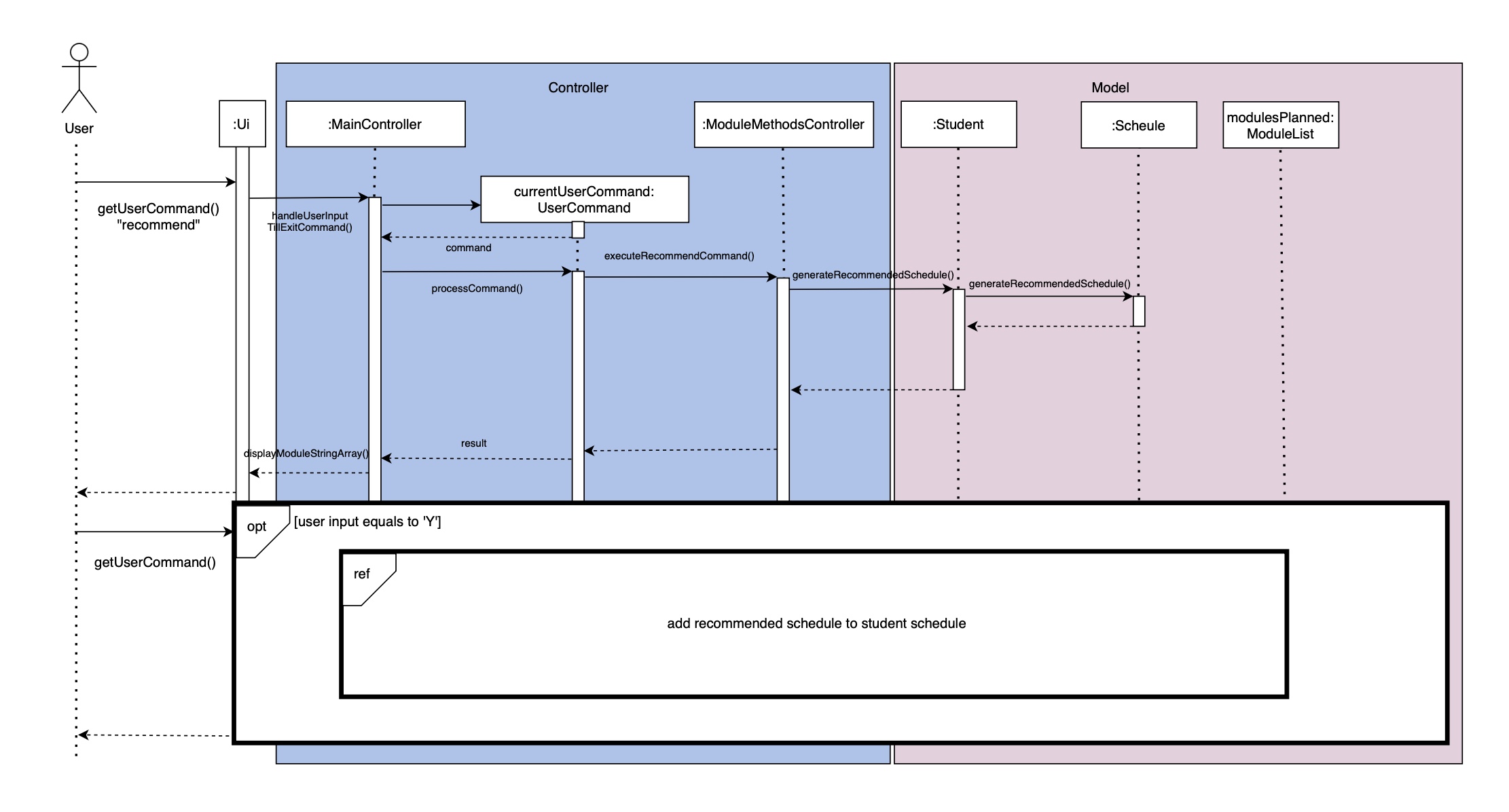
Recommended a schedule based on the user’s major:
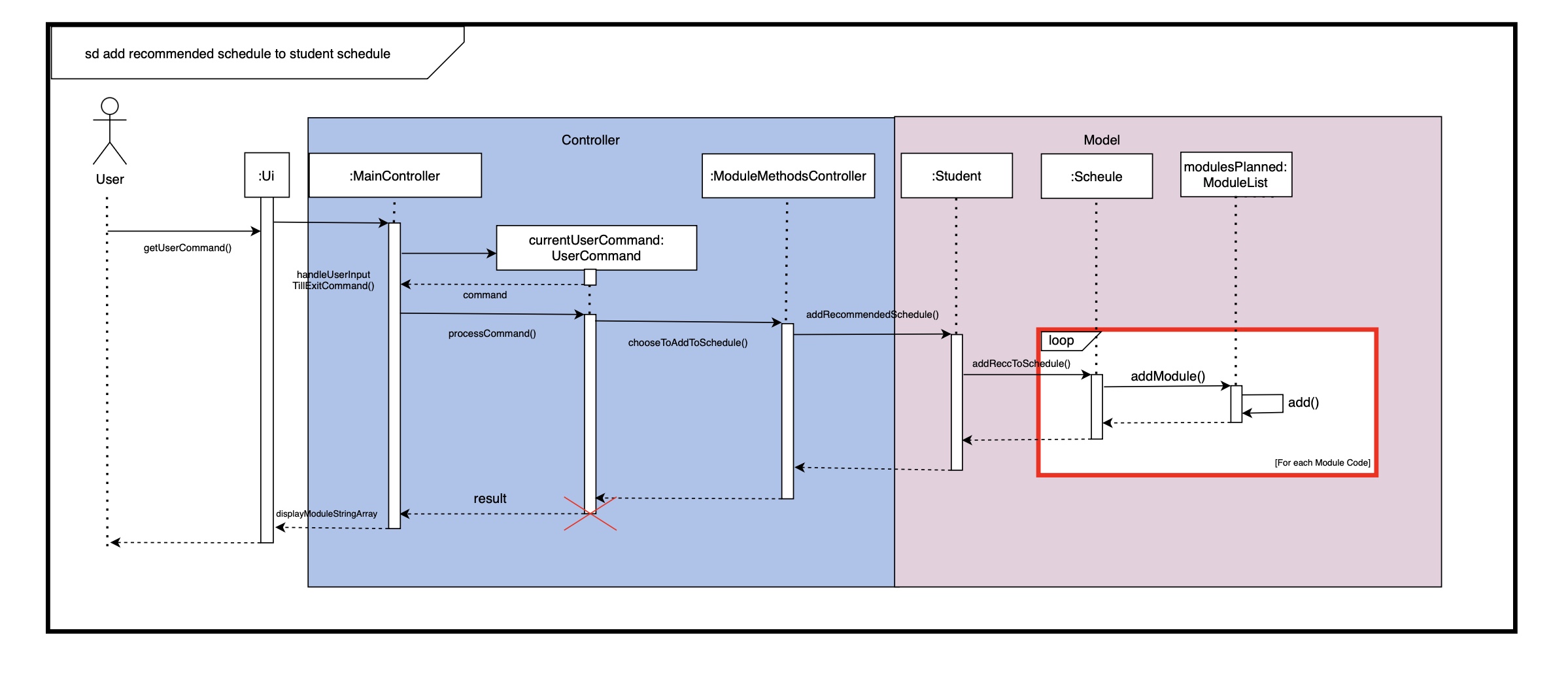
Based on the course, we will provide a recommended schedules that is sorted based on prerequisites.
This feature is facilitated by the ModuleMethodsController. which stores information about the schedule and performs actions like add and remove from schedule.
Usage Examples
Here are a few examples of how the “Recommend schedule” feature behaves:
Step 1: Recommend schedule for computer engineering(CEG)
Command: recommend
Response:
1. GEA1000 2. MA1511 3. MA1512 4. DTK1234 5. GESS1000
6. CS1231 7. CS1010 8. GEN2000 9. EG2501 10. EG1311
11. GEC1000 12. PF1101 13. CDE2000 14. IE2141 15. CG1111A
16. EG2401A 17. ES2631 18. ST2334 19. MA1508E 20. CG2023
21. CG2111A 22. CS2040C 23. CG2027 24. EE2026 25. EE4204
26. EE2211 27. CG2271 28. CS2113 29. CG2028 30. CP3880
31. CG4002
Here you go!
Taking the modules in this order will ensure a prerequisite worry free uni life!
Do you want to add this to your schedule planner? (This will overwrite your current schedule!)
Please input 'Y' or 'N'
Step 2 (Only to be done after step 1):
Command: Y
Response:
Here is your schedule planner!
Sem 1: X GESS1000 X DTK1234 X MA1512 X MA1511 X GEA1000
Sem 2: X EG1311 X EG2501 X GEN2000 X CS1010 X CS1231
Sem 3: X CG1111A X IE2141 X CDE2000 X PF1101 X GEC1000
Sem 4: X CG2023 X MA1508E X ST2334 X ES2631 X EG2401A
Sem 5: X EE4204 X EE2026 X CG2027 X CS2040C X CG2111A
Sem 6: X CG2028 X CS2113 X CG2271 X EE2211
Sem 7: X CG4002 X CP3880
Sem 8:
Happy degree planning!
Clear Schedule Feature
The clear schedule mechanism is facilitated by ModuleMethodsController. It clears the schedule of the user and resets
the completion data of the modules in the schedule.
Usage Examples
Here is an example of how the clear schedule feature behaves:
Example 1:
Step 1. The user inputs the clear command to clear their schedule. The clear UserCommand() object is created
from the user input.
Step 2. If the user inputs are valid, processCommand is called by the UserCommand object. The command is then
passed to the ModuleMethodsController through executeClearModuleCommand(). The ModuleMethodsController would then
call the clearAllModuleFromSchedule() method in Student, which would replace the current Schedule object in
Student with a new schedule and reset completedModuleCredits in the Student object to 0.
Step 3. Upon successful execution of all of the above, ModuleMethodsController would then construct a message
which would be returned to the UI class to be formatted to the Command Line Interface.
The following sequence diagram shows how the clear command works:
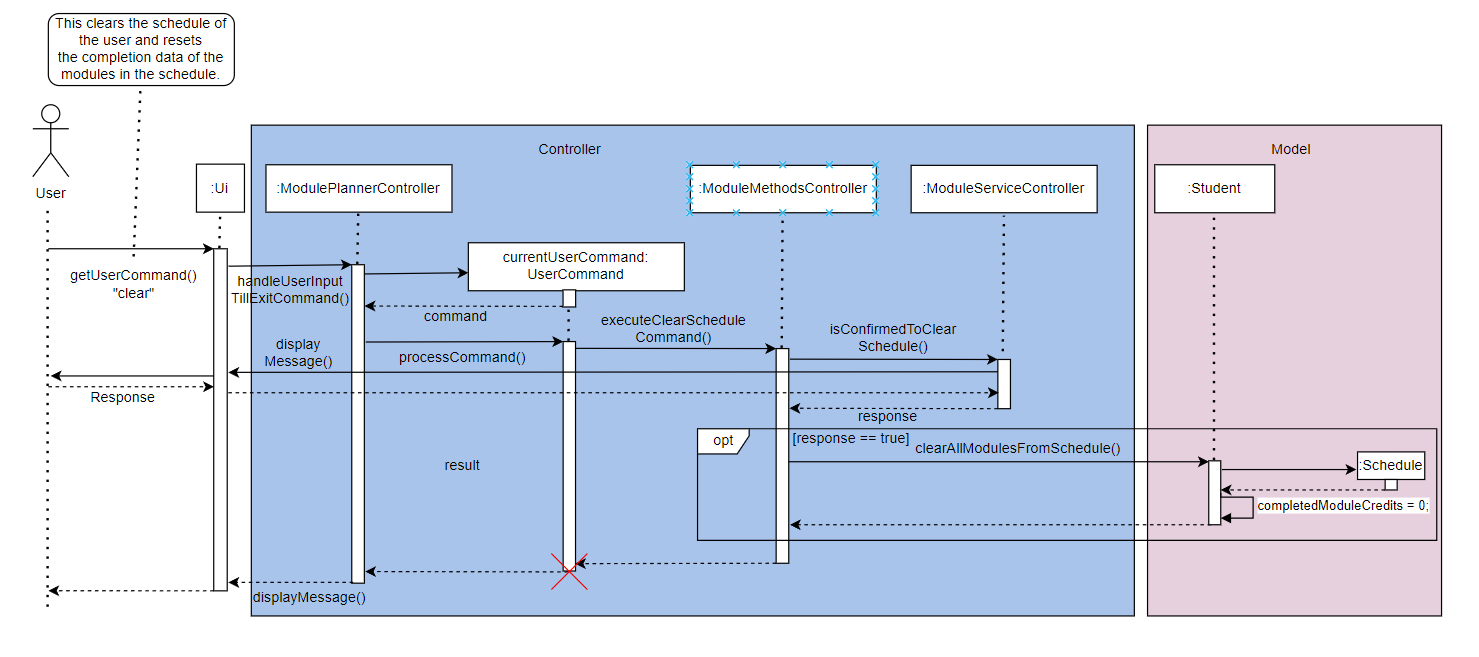
Get information about modules (from the NUSMods API)
The information feature returns information about the module at the user’s request. It accepts 3 commands, ‘description’, ‘workload’ and ‘all’. The ‘description’ command returns a string description of the module, the workload command returns an array, and all displays the module title and module code for all modules present in the NUSMods directory.
getFullModuleInfo(major)– Returns thefilePathfor the requirements of a specified major.sendHttpRequestAndGetResponseBody(String url)– Displays the overview of modules required.getDescription(String moduleCode)– Returns thelongestLineLengthof the file f.listAllModules(),printDoubleTopLine(),printBottomLine(),printDoubleBottomLine()` – Displays lines for formattinginfoCommands(String command, String userInput),printDoubleTopLine(),printBottomLine(),printDoubleBottomLine()` – Displays lines for formatting
Usage Examples
Here are a few examples of how the Show Required Modules Feature behaves:
Example 1:
Command: required
Response: Module requirements for major selected by user
List Required Modules Left Feature
The following sequence diagram shows how the Left Command function works.

When the user’s command is determined to be left, the program implements the following operations:
Function List
new ArrayList<String>(): Instantiate moduleCodesLeftstudent#getModuleCodesLeft(): Calls the functions below to get the module codes leftschedule#getModulesPlanned(): Returns modulesPlanned (Module List)modulesPlanned#getCompletedModuleCodes(): Returns completedModuleCodes (ArrayList) completedModuleCodes#contains(moduleCode): Returns true if completedModuleCodes contain moduleCodemoduleCodesLeft#add(moduleCode): Add moduleCode to moduleCodesLeftModuleMethodsController#showModulesLeft(moduleCodesLeft): Calls methodsdisplayMessage("Modules Left:")andprintModuleStringArray(moduleCodesLeft)to display the modules left to the user
Usage Examples
Here are a few examples of how the List Required Modules Left Feature behaves:
Example 1:
- Major is CEG
- Modules CG1111A, MA1511, MA1512, CS1010, GESS1000, CFG1002 are added to schedule planner and completed
Command: left
Response:
Required Modules Left:
1. GEC1000 2. GEN2000 3. ES2631 4. GEA1000 5. DTK1234
6. EG1311 7. IE2141 8. EE2211 9. EG2501 10. CDE2000
11. PF1101 12. CG4002 13. MA1508E 14. EG2401A 15. CP3880
16. CG2111A 17. CS1231 18. CG2023 19. CG2027 20. CG2028
21. CG2271 22. ST2334 23. CS2040C 24. CS2113 25. EE2026
26. EE4204
Pacing and MC Calculation Feature
The following sequence diagram shows how the pace command function works.

The “Pacing and MC Calculation” mechanism is implemented to help users track their academic progress and remaining Modular Credits (MCs) required for graduation.
This feature is facilitated by the ModuleMethodsController. It calculates the average amount of modular credits the user
has to take in each semester in order to graduate on time.
Usage Examples
Here are a few examples of how the “Pacing and MC Calculation” feature behaves:
Example 1: Calculate Remaining MCs
Command: pace Y1/S1 (assuming 0 modular credits were done in semester one)
Response:
You have 160MCs for 7 semesters. Recommended pace: 23MCs per sem until graduation
Example 2: Calculate Remaining MCs (No Semester Specified)
Note: If no semester is specified, we will take the initial semester that the user has inputted upon initialisation.
Command: pace (Assuming user is y2/s1 and has completed 40 modular credits)
Response:
You have 120MCs for 6 semesters. Recommended pace: 20MCs per sem until graduation
Modify lessons in the Weekly Timetable Feature
User Input: timetable modify
The following sequence diagram details the process of the ‘timetable modify loop’

Function List
getUserCommand: Retrieves user input for a timetable command.getArguments: Retrieves arguments from a TimetableUserCommand.isModifyExit: Checks if the user entered ‘exit’ as an argument.addLecture: Adds a lecture to the selected module.addTutorial: Adds a tutorial to the selected module.addLab: Adds a lab to the selected module.isModifyClear: Removes all lessons for the selected module.saveTimetable: Saves the current timetable to storage.printTimetable: Returns a formatted timetable display to the command-line interface.
Show Weekly Timetable Feature
User Input: timetable show
The following sequence diagram shows how the timetable show feature works:

The following sequence diagram shows how the printTimetable operation works:
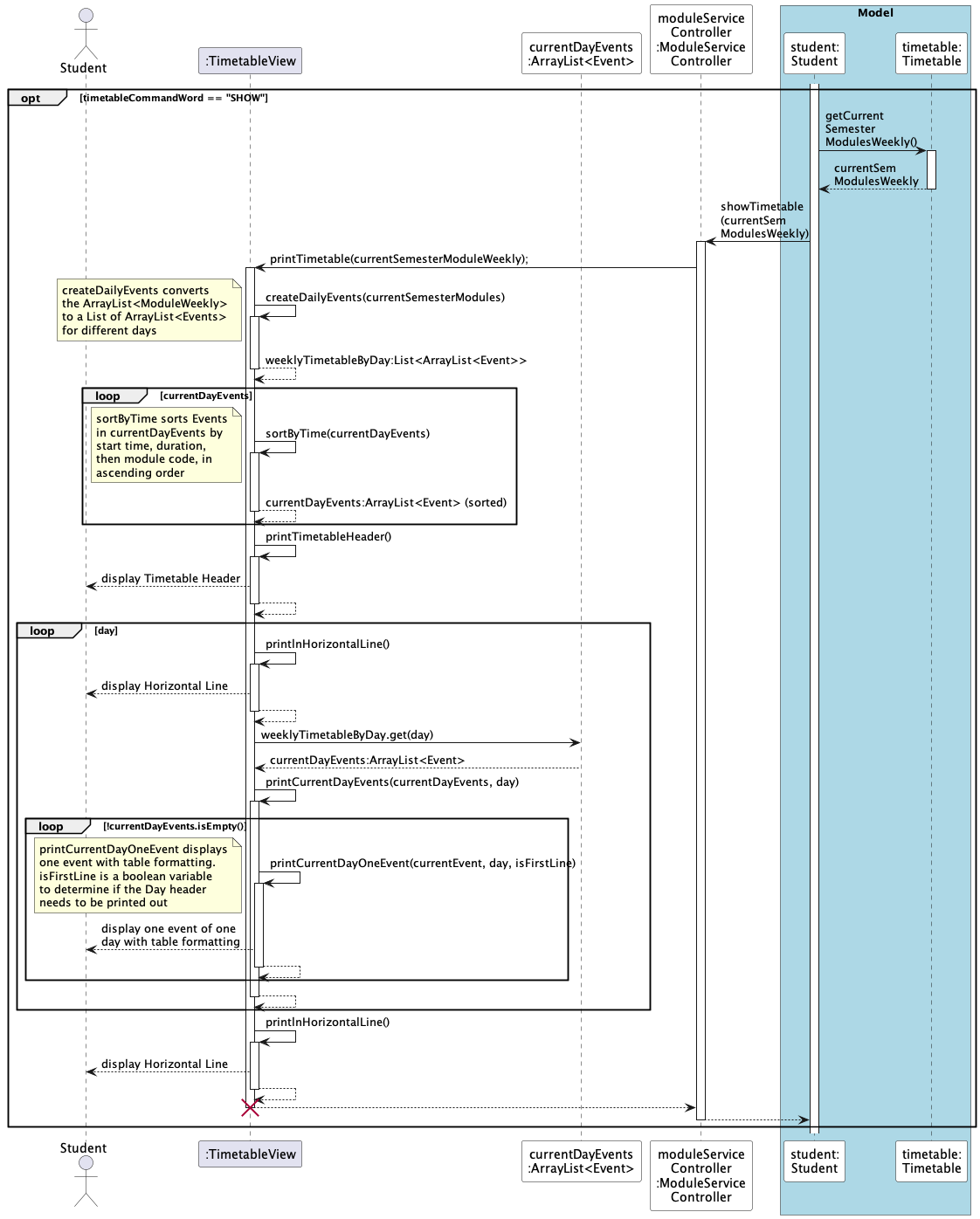
When the user’s command is determined to be timetable show, the program implements the following operations:
Function List (when timetableCommandWord == “SHOW”)
getCurrentSemesterModulesWeekly(): Returns the ArrayList of ModuleWeekly for the current semestershowTimetable(currentSemModulesWeekly): Calls the printTimetable functionprintTimetable(currentSemModulesWeekly): Prints the Weekly Timetable to the consolecreateDailyEvents(currentSemesterModules): Converts the ArrayListto a List of ArrayList for different days sortByTime(currentDayEvents): Sorts Events in currentDayEvents by start time, duration, then module code, in ascending orderprintTimetableHeader(): Display timetable headerprintlnHorizontalLine(): Display horizontal lineprintCurrentDayEvents(currentDayEvents, day): Calls the function below to display the day’s eventsprintCurrentDayOneEvent(currentDayEvents, day, isFirstLine): Display the current event of the current day
Example of usage:
Scenario: The lessons have been specified in Timetable Modify Mode
- CS2101 has a lecture at 5 for 2 hours on Monday
- GESS1000 has a lecture at 11 for 3 hours on Tuesday
- GESS1000 has a tutorial at 19 for 0 hours on Wednesday.
User input:
timetable show
Expected outcome:
------------------------------------------------------------
| DAY | TIMETABLE |
------------------------------------------------------------
| Monday | CS2101 Lecture (5am-7am) |
------------------------------------------------------------
| Tuesday | GESS1000 Lecture (11am-2pm) |
------------------------------------------------------------
| Wednesday | GESS1000 Tutorial (7pm) |
------------------------------------------------------------
Design considerations
Aspect: How timetable is printed:
Current implementation: One table row per day
- Pros: Each table cell can be wider allowing each event to be printed in 1 line
- Cons: The user needs to read the time for each event to understand when they are free.
Previous implementation: One table row per hour, one table column per day
- Pros: The user can see when they are free by day and hour easily
- Cons: The console must be wide enough for it to be usable and aesthetic. Each table cell for an event was only about 11 characters wide.
Product scope
Target User Profile
-
Computer Engineering and Computer Science Students at NUS
-
Desktop CLI Preference: Students in Computer Engineering and Computer Science at NUS show a preference for desktop Command Line Interface (CLI) apps over other planners.
-
Typing-Centric Interaction: This group favors typing for efficiency, valuing keyboard-based operations over mouse interactions.
-
Minimization of NUSMods Website Reliance: These students seek to reduce dependence on frequent NUSMods website visits. Instead, they prefer a comprehensive planner in a desktop CLI environment, meeting their specific needs.
Value Proposition
Efficiently navigate and organize a planner without the typical delays associated with mouse-driven GUI applications. Recognizing the substantial module load and hectic schedules faced by NUS engineering students throughout their four-year program, this application is designed to streamline the module planning process. By eliminating the need for frequent reference to various websites and GUIs, such as NUSMods and scheduling sites, the app aims to enhance the efficiency of module planning for these students.
User Stories
| Version | As a … | I want to … | So that I can … |
|---|---|---|---|
| v1.0 | new user | view help | refer to them when I forget how to use the application |
| v1.0 | user | view my pace | graduate on time |
| v1.0 | user | view the required modules I am left with for my major | plan ahead for other semesters |
| v2.0 | user | search for specific modules based on keywords, course codes, or professors’ names | quickly find the modules I need for my semesters |
| v2.0 | user | alter (add, swap, delete) the modules in the schedule planner | update the recommended schedule to my preferences |
| v2.0 | user | get the recommended schedule for my major | have a starting point to use the app |
| v2.0 | user | get an overview of module requirements for my major | know which modules I must take to graduate |
| v2.1 | user | shift the modules in the schedule planner | more easily edit my schedule and save more time |
| v2.1 | user | plan my weekly timetable for my current semester | keep track of my weekly lessons for my current semester |
| v2.1 | user | mark modules I have added as completed | keep track of my progress |
Non-Functional Requirements
General Requirements
- NUSDegs should work on any mainstream OS that has Java 11 or above installed.
- NUSDegs requires a stable internet connection to be able to use its maximal functionalities as NUSMods API is used.
Specific Requirements
- Year 4 Semester 2 students aren’t able to use the app! (As we specifically cater the app to only students who have at least one semester left!)
- Due to the requirements of the CS2113, users are allowed to edit the txt files created. However, the course
should not be modified from “CEG” to “CS” and vice versa
in the txt file as it will break the prerequisite constraints in your
schedule and may cause the schedule to not work as intended (e.g show the incorrect preclusion).
- This is due to the prerequisite algorithm that takes into account your course. Hope you understand!
- Users are strongly recommended to not modify the data/schedule.txt as well as the schedule is supposed to be sorted based on prerequisites. Hence, a manual modification of an invalid module into the schedule.txt file may cause your schedule info to be corrupted and therefore lost!
- The prerequisites are calculated based on module data available on NUSMods API, where some modules had complicated prerequisites. Thus, we were unable to process it so an error message will be returned. Unfortunately for such modules, you would not be able to add them to your schedule as well! (This is something we would require more time and hopefully be able to work out in the future!)
___________________________________________________________
Input command here: prereq cs3282
Sorry but we could not get the prerequisite for CS3282 as NUSMods API provided it in a invalid format :<
___________________________________________________________
- Module data is limited to what is available on NUSMods API, where some modules are outdated. NUSDegs will be able to include them into your schedule planner, even though their prerequisites cannot be calculated.
Input command here: prereq cs3230R 1. CS2020 2. CS1231 ___________________________________________________________ Input command here: prereq cs2020 Invalid Module Name ___________________________________________________________ Input command here:
Glossary
- Mainstream OS - Windows, Linux, Unix, OS-X
- CLI - Command Line Interface
- API - Application Programming Interface
Instructions for manual testing
Launch
- Ensure that you have Java 11 or above installed.
- Download the latest version of
NUSDegsfrom here - Download the CS2113-T17-4.NUSDegs.jar to the folder you want to use as the home folder for NUSDegs.
- Open a command terminal, cd into the folder you put the .jar file in, and run the command java -jar CS2113-T17-4.NUSDegs.jar to run the application.
Starting point:
Hey there CS and CEG Students! Welcome to
_ _ _ _ ____ ____
| \ | | | | / ___|| _ \ ___ __ _ ___
| \| | | | \___ \| | | |/ _ \/ _` / __|
| |\ | |_| |___) | |_| | __/ (_| \__ \
|_| \_|\___/|____/|____/ \___|\__, |___/
|___/
Attempting to look for your data file...
Loading (.O_O.)
Looks like you're new, new save files will be created.
Input your study details (Prompts Provided) Prompt for name:
___________________________________________________________
Please enter your name:
Example Input for name: Janelle
Prompt for major:
Welcome Janelle! What major are you? (Only two available: CEG or CS)
___________________________________________________________
Please enter major:
Example Input for major: CEG
Prompt for current academic year:
What Year and Semester are you? Ex: Y1/S2 for year 1 semester 2
___________________________________________________________
Please enter your current academic year:
Example Input for current academic year: y2/s1
Student details have been created
New save files successfully created!
Now you're all set to use NUSDegs to kick start your degree planning!
Type 'help' to see the available commands
Prompt for command:
___________________________________________________________
Input command here:
Modify lessons in the Weekly Timetable Feature
Set-up:
- Add a module to your current semester:
add cs1010 3``` -
Module Successfully Added Sem 1:
Sem 2:
Sem 3: X CS1010
Sem 4:
Sem 5:
Sem 6:
Sem 7:
Sem 8: _______________________ Input command here: ``` - Enter timetable modify:
timetable modify``` List of modules in current semester: CS1010
Entered Timetable Modify Mode To add a lesson to a module: [moduleCode] [lessonType] [startTime] [duration] [day] lessonType lecture, tutorial, lab startTime integer from 5 to 23 (representing 5am to 11pm) duration time in hours day eg. monday, tuesday, wednesday To clear all lessons for a module: [moduleCode] clear To exit timetable modify: exit _______________________ Input timetable modify command here:
#### Test Cases:
Success test case 1: `cs1010 lecture 9 2 monday`
Expected output:
| DAY | TIMETABLE | ———————————————————— | Monday | CS1010 Lecture (9am-11am) | ————————————————————
Success test case 2: `cs1010 lab 20 0 friday`
Expected output:
| DAY | TIMETABLE | ———————————————————— | Monday | CS1010 Lecture (9am-11am) | ———————————————————— | Friday | CS1010 Lab (8pm) | ————————————————————
Success test case 3: `cs1010 clear`
Expected output:
All lessons for selected module are cleared. Timetable view is unavailable as modules in your current semester have no lessons yet. To add a lesson for a module, enter: [moduleCode] [lessonType] [startTime] [duration] [day] To clear lessons for a module, enter: [moduleCode] clear To exit Timetable Modify Mode, enter: EXIT
Failure test case 1: `cs1010 lect 10 1 saturday`
(valid lesson types are only lecture, tutorial, lab)
Expected output:
Invalid lesson type Please enter in the format: [moduleCode] [lessonType] [startTime] [duration] [day] If you wish to clear lessons for a module, enter: [moduleCode] clear If you with to exit modify, enter: exit
Failure test case 2: `cs1010 lect 10 2`
(valid lesson types are only lecture, tutorial, lab)
Expected output:
Invalid Number of Arguments Please enter in the format: [moduleCode] [lessonType] [startTime] [duration] [day] If you wish to clear lessons for a module, enter: [moduleCode] clear If you with to exit modify, enter: exit
Other incorrect timetable commands to try:
`cs101 lecture 10 2 monday`
`lecture 10 2 monday`
Expected output: Error message specific to number of arguments (clearing lessons and exiting needs 2 and 1 arguments respectively) then validity of arguments
- Exit timetable modify: `exit`
Exited Timetable Modify Mode ```